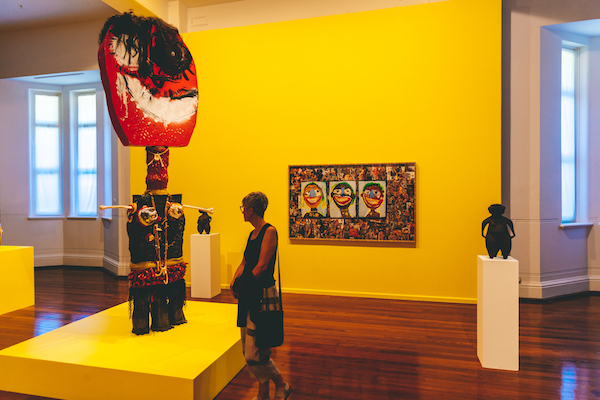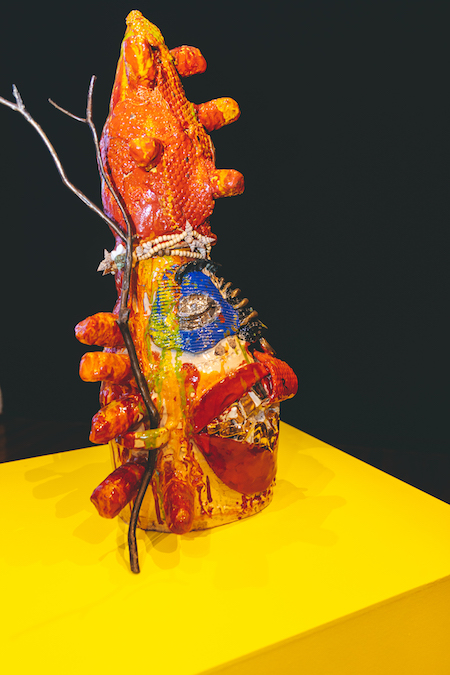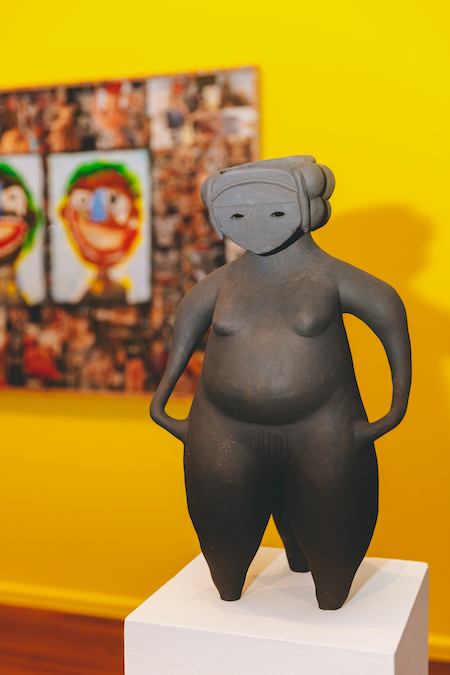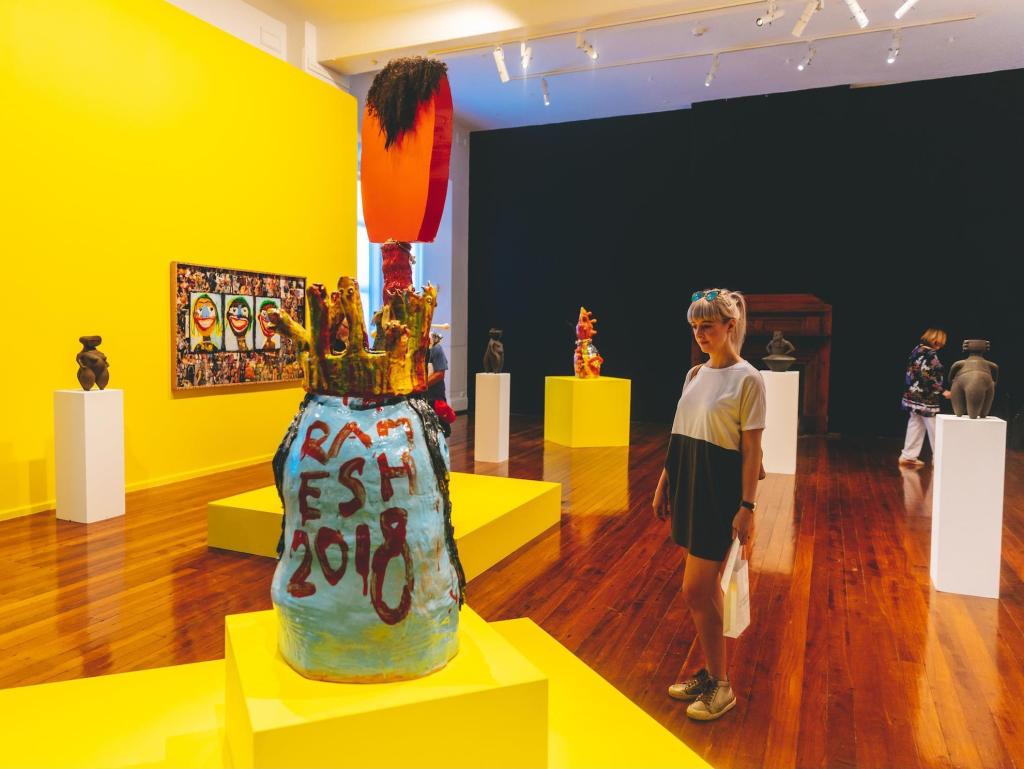Installation view, Idols, Fremantle Arts Centre, 2019 Perth Festival. Photo: Cam Campbell.
As part of the Perth Festival, the Fremantle Arts Centre has gone down the popular route of a contemporary ceramic show, however, Idols: Ramesh Nithiyendran and Renee So, is far less predictable than one might have expected.
There has been an incredible vibe and hype around contemporary ceramics in recent years, one that is arguably moving towards a “stale” quality. It is a difficult space in which to operate, to keep the work in balance, authentic and fresh, for an artist like Ramesh Nithiyendran, whose career has escalated at lightning speed parallel to this rising trend.
Nithiyendran’s career was kickstarted by winning the 2015 Sidney Myer Fund Australian Ceramic Award. In just three years since, he has had a solo exhibition at the National Gallery of Australia, been included in the 2016 Adelaide Biennial of Australian Art, represented at the 2016 Kuandu Biennale (Taipei), 2018 Dhaka Art Summit, and featured in the Encounters section at Art Basel Hong Kong, among others.
And yet, this is the first significant body of work for the artist to be shown in Perth, where his work is paired with that of Hong Kong-born ceramicist Renee So.
Most obviously, both artists work in a hand-built figurative tradition, but where So meticulously smooths the surface of her stoneware idols, Nithiyendran’s sculptures carry his raw, gestural hand prints.
What is curious about this punchy, contrasting show is that it has clearly been considered as one installation; not a two-person show. The pieces are interspersed, playing off the scale and physical gesture of each other, and conceptually, it is tight.
What really sings for me is that the scale and colour of Nithiyendran’s works read discursively against the more logically natural quality of So’s pieces, and through that juxtaposition you can read both with fresh eyes. In other words, each throws the other into relief.

Installation view, Idols, Fremantle Arts Centre 2019, Perth Festival. Photo: Cam Campbell.
From a conceptual perspective, when placed together, the reference points come across as rather fluid, malleable – a kind of smorgasbord of art history, religion and gender; on the surface offering no cohesive understanding, but nevertheless, triggering an appetite to pry, try and ponder.
Perth Festival, and Idols curators Felicity Fenner and Anne Loxely said of the exhibition: ‘Nithiyendran and So are at the vanguard of this movement. Like many of the new generation of ceramists, they subvert, albeit with very different outcomes, the medium they deploy.’
It’s a strange “no brainer” that Fenner / Loxely would place their work together, and the “push and pull” energy it offers is exciting for the viewer.
Both artists flesh out notions of power, gender, sexuality, materiality and authority, and embrace the pedestal to extend that conversation. There is an immediate disjuncture between So’s earthy monochrome figures and the high volume colour of Nithiyendran’s figures that is amplified at every opportunity.
Nithiyendran intentionally takes a break from his use of punchy pink and soft blue backgrounds, rather turning to a citrus yellow as the backdrop for walls and pedestals in this exhibition. It is an interesting choice, moving away from gender stereotypes to a colour often associated with barriers and warnings, and with Hindu spirituality and radiance. He told ArtsHub that he was aiming at a ‘synthetic counterpoint to So’s earthy material’.
Set against colonial fireplaces, soaring ceilings and punctuating black walls, the layers are well in play before even considering the work in this exhibition.

Installation view, Ramesh Nithiyendran’s work in Idols, Fremantle Arts Centre 2019, Perth Festival. Photo: Cam Campbell.
In conversation with ArtsHub, Nithiyendran said: ‘It’s just like a group show, you have to relax about that [curatorial authorship]. From an audience perspective, people are used to seeing the repetition of things, so it’s good to get them to think a bit more about how they can make connections between the works. While there are overt connections between my work and Renee’s, there are also quite subtle ones.’
The exhibition includes two works from Nithiyendran’s Heads with Many Piercings series as well as the large work Pewter Deity perched atop custom plinths, but now with a polystyrene head (due to damage while in storage). Meanwhile, So presents work from her Women series and Vessel Man series. There are also three wall-based works by the artists, which feel a little unnecessary.

Installation view, Renee So’s work in Idols, Fremantle Arts Centre 2019, and Perth Festival. Photo: Cam Campbell.
There is something lovely about the way So’s works are grounded – they feel weighted by their feminine girth, often carrying three legs and double handles moving with ambiguity between figure and vessel.
Similarly, Nithiyendran’s heads are triangulated, or without formal anatomy, vaguely self referential and yet totemic in their presence. There is a lusciousness to his glazes and use of precious metals and glitzy beads, while the neutral surfaces of So’s vessels have their own seductive quality. A surprise lies in the scored detail of public hair on some of So’s figures, which pulls her objects back to a contemporary reality.
Integral to So’s repertoire of cultural references is a catalogue of prehistoric pottery found at the Victoria and Albert Museum in her home town of London, an amalgam of Assyrian friezes, 16th century stoneware jugs, 19th century stereotype images of the dandy, European Ballarmine jugs and Mesopotamian forms.
Nithiyendran equally draws upon art history, internet pornography, fashion and emojis without hierarchy – a kind of fair game mosh pit where anti art modes and sophisticated technique and conceptual rigor can co-exist.
Interestingly, both artists come from migrant backgrounds, calling on traditions and beliefs to help navigate contemporary understanding but they don’t overly play one hand over another.
Idols is a curious tandem dialogue about material, gender, memory and cultural platforms, and in keeping with the adage “opposites attract”, this pairing works well and opens up fresh conversations at a time when most needed.
Rating: 4 out of 5
Idols – Ramesh Nithiyendran and Renee So
Fremantle Arts Centre
Western Australia
7 February – 31 March
Curated by Felicity Fenner and Anne Loxely





